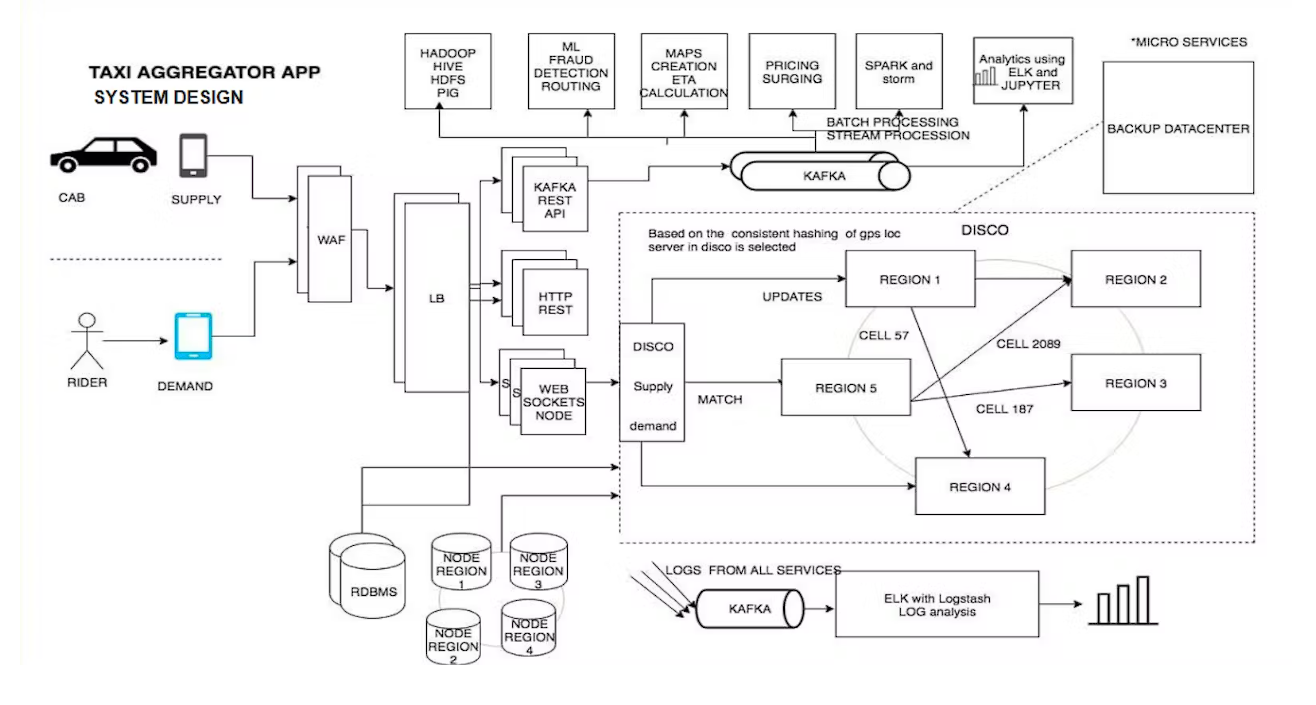Architecture and Design of a Taxi Aggregation Platform
 Mistry DaxeshKumar NitinKumar
Mistry DaxeshKumar NitinKumar
Behind the App: Unveiling the Taxi Aggregator Application Architecture
In today's fast-paced world, ride-hailing apps have become essential to our daily commute. Ever wondered how these apps connect riders with drivers so seamlessly? The answer lies in a complex, yet well-orchestrated system architecture.
This blog post delves into the intricate details of a ride-hailing system architecture, based on the provided diagram. By understanding the interplay between various components, we can appreciate the magic behind those convenient taps on your smartphone.
Core Components of the Ride-Hailing System
The diagram presents a high-level architecture for a ride-hailing service. Here’s a breakdown of the essential components:
Messaging Service
Acting as the communication hub, the messaging service facilitates real-time information exchange between riders and drivers. Think of it as a central message board where everyone can see updates.
Dispatch Services
This component handles the rider's request, assigning it to the most suitable driver based on factors like location, availability, and rider rating.
Databases
User DB MySQL Cluster (Master/Slave):
Stores user information such as profiles, preferences, and history.
Provides high availability and redundancy through a master-slave setup.
Redis Cluster (Cache):
Caches frequently accessed data for fast read and write operations.
Used by multiple services to reduce database load and improve performance.
Trip DB MySQL Cluster (Master/Slave):
Maintains trip-related data, including ride requests, trip progress, and completion records.
Ensures data consistency and reliability with a master-slave configuration.
Cassandra Cluster:
Used for archiving trip logs due to its high write throughput and scalability.
Stores historical trip data for analytics and long-term access.
Geo Location Database:
Stores real-time location data for cabs and users.
Facilitates efficient location tracking and proximity calculations.
Driver DB MySQL Cluster (Master/Slave):
Contains driver-specific information such as profiles, status, and earnings.
Provides data reliability and availability with a master-slave setup.
Payment DB MySQL Cluster (Master/Slave):
Stores payment transactions, fare details, and financial records.
Ensures secure and reliable payment processing with redundancy.
Trip Tracker
The trip tracker monitors the location of riders and drivers throughout the trip, providing real-time updates.
Location Service
This service underpins location tracking by supplying location data to other components.
Real-Time Analytics & Trip Analytics
These components analyze data to identify trends, improve efficiency, and optimize pricing.
WebSocket Gateway & WebSocket
These facilitate two-way communication between the app and the server, enabling features like real-time trip updates and in-app chat.
Notifying Service
This component keeps riders informed about their trip status through SMS, email, or push notifications.
ETA Service
Calculates the estimated time of arrival for the driver, providing riders with timely updates.
Billing Service
Handles trip fares, taking into account distance traveled, time of day, and other relevant factors.
How It Works: A Step-by-Step Breakdown
Rider Requests a Trip: A rider opens the app and enters their pickup and drop-off locations.
Messaging Service in Action: The rider’s request is sent via the messaging service.
Dispatch Service Takes the Wheel: The dispatch service receives the request and finds the most suitable driver based on predefined criteria.
Driver Gets the Nod: The chosen driver is notified about the trip details through the messaging service.
Rider Meets Driver: The rider is informed about the driver's details and estimated arrival time.
Real-Time Tracking Takes Over: Both rider and driver can track each other’s location on a map throughout the trip.
Smooth Ride, Seamless Payment: The trip concludes, and the billing service calculates the fare based on the predetermined rates.
Additional Components:
Kafka (Purple):
Acts as a distributed messaging system for real-time data streaming between services.
Ensures decoupling of components and reliable message delivery.
User App:
The front-end application used by passengers to book rides, track cab locations, make payments, and manage their profiles.
Communicates with various backend services via the load balancer to fetch and update data in real-time.
Driver Earning Page:
Interface for drivers to view their earnings and payment history.
Fetches data from the Payment Service and presents it to drivers.
Conclusion: A Symphony of Technology
The ride-hailing system architecture is a masterpiece of interconnected services, each playing a vital role in ensuring a smooth and efficient experience for riders and drivers alike. From real-time communication to intelligent dispatching and seamless payment processing, this intricate dance of technology keeps our cities moving.
By understanding these components, we gain insight into the sophisticated technology that powers our daily commutes, making ride-hailing apps an indispensable part of modern urban life.
Subscribe to my newsletter
Read articles from Mistry DaxeshKumar NitinKumar directly inside your inbox. Subscribe to the newsletter, and don't miss out.
Written by
